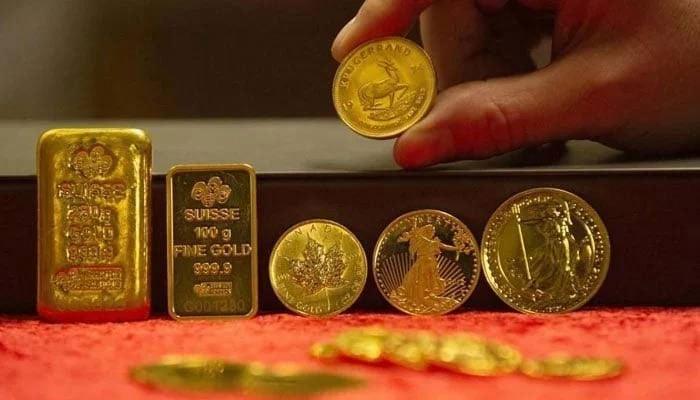Bullion prices see sharp decline as Pakistan gold market switches to interbank trading
Under new formula, gold rates will be higher by around $5 with a certain percentage per tola compared to international rates
October 13, 2023

- Bullion trading continues to witness changes after crackdown.
- Transition aims to align local gold pricing with int'l standards.
- Gold closed on Thursday at Rs197,200/tola.
KARACHI: Following a switch to a formula based on interbank trading aimed to align the yellow metal’s price with international standards and curb speculative practices, gold saw a sharp decline in its value on Thursday, reported The News.
According to data from the All Sindh Sarafa Jewellers Association (ASSJA), gold rates declined to Rs197,200/tola at the end of the day's trading on Thursday, reflecting a substantial decline from the previous rates.
The price of 10 grams of gold also registered a notable decrease, falling by Rs6,684 to reach Rs169,070.
Simultaneously, gold in the international market went up by $13, settling at $1,885/ounce.
However, silver rates remained stable in the local market, with no change reported. The rates for silver held steady at Rs2,500/tola, while 10 grams silver also maintained the same value, standing at Rs2,143.34.
New formula
Bullion traders told the publication that the shift to interbank trading was a significant development. Under the new formula, gold rates in the Pakistani market will be higher by around $5 with a certain percentage per tola compared to the international rates.
These rates are then converted into Dirham rates and subsequently into Pakistani rupees. This transition aims to align local gold pricing more closely with international standards.
"The move towards interbank trading is a pivotal step in achieving pricing uniformity," said President of the All Pakistan Gems and Jewellers Association Al-Haj Haroon Rasheed Chand.
"The new formula aims to mitigate discrepancies and speculative pricing practices that may have influenced the local gold market in the past."
The gold dealer clarified that the change in approach would ensure fair and consistent pricing in the local gold market. He noted that speculators and black marketeers had been selling gold at significantly higher rates, creating disparities in pricing.
"The transition to an interbank-based system aims to address these concerns and provide more transparent and competitive pricing for consumers and traders."
Chand said the drop in gold prices was a positive development, and with most of the local gold traded in the market, it was essential to ensure that these pricing changes were effectively enforced.
As the gold market adjusts to this new pricing framework, industry stakeholders and market participants will closely monitor its impact on local gold rates.
The shift towards interbank trading is seen as a positive step in enhancing transparency and stability in the local gold market.











